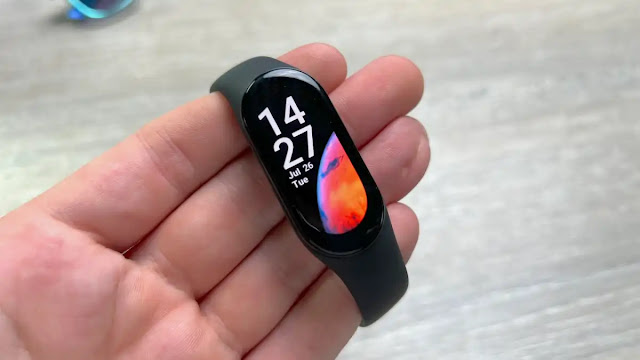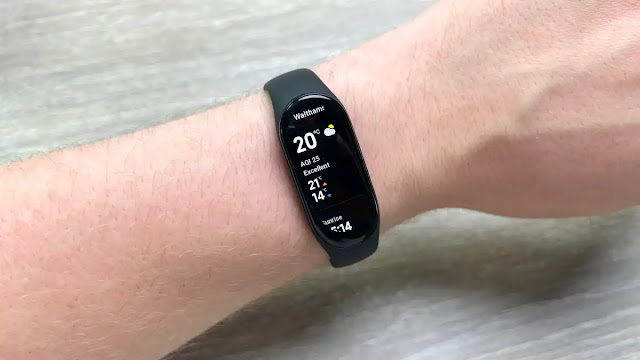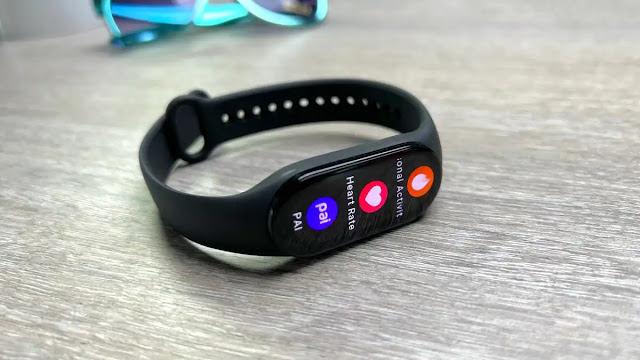Xiaomi continues to improve the capabilities of the Mi Band line - but at a cost.
Pros
- Featured packed for the price
- All-day heart rate, blood oxygen and stress tracking
- Support for 120 types of exercise
- Larger always-on display
Cons
- Always-on display comes at a big cost to battery
- More expensive than its predecessor
- Not the smartest wearable
Our Verdict
- Xiaomi continues to offer one of the most feature-packed wearables in the budget fitness tracker market with the Mi Band 7. It boasts key display and fitness tracking upgrades to provide better insight into your health, but it’s still not quite as smart as some alternatives, and battery life can be hit-and-miss.
Xiaomi has made a name for itself with its ultra-affordable, feature-packed Mi Band series, and the latest Xiaomi Mi Band 7 looks to continue that trend with a bigger display, improved all-day tracking capabilities and new exercise measurement metrics, all in a slightly more expensive package.
But, despite the slight price hike, the Mi Band 7 is still an impressively capable fitness tracker ideal for those that want to get more insight into their health, sleep and fitness – just don’t expect smartwatch-level smarts.
Design & Build
- Large 1.62in always-on display is a bonus
- Improved charger design
- Compact, sleek design that doesn’t draw attention
At a glance, you might not see much of a difference between the Xiaomi Mi Band 7 and its predecessor, the Xiaomi Mi Band 6, but there’s one crucial difference: the size of the display.
One exciting new addition is the introduction of always-on display tech. As the name suggests, the display can stay on at low brightness to provide constant access to the time, fitness tracking bars and any other widgets you have on your chosen watchface – though at a huge cost to battery, but more on that in a bit.
Flip the fitness tracker over and you’ll find the usual suite of sensors and Xiaomi’s proprietary charging connection points. The good news is that, unlike previous generations, the tweaked charger design means you no longer need to remove the tracker from the strap to top it up.
As with previous generations, there’s a variety of flexible silicone straps available to help inject a bit of colour into proceedings, but overall, it’s an understated fitness tracker that doesn’t draw too much attention to itself – unless you opt for a bold, bright watch face that is!
Software & Features
- No third-party apps, payments or smart assistant support
- Basic functions like weather, calendar and music control work fine
- Plenty of watchfaces to choose from
The Xiaomi Mi Band 7 is a fitness tracker first and foremost, and that means it’s not quite as smart or capable as dedicated smartwatches on the market.
The Mi Band 7 lacks key smarts including the ability to utilise the built-in NFC for payments (outside of China, anyway!), voice assistant support and third-party apps. However, for those that want more of a smartphone ‘companion’ than a full-blown smartphone on the wrist, the inexpensive wearable ticks a lot of boxes.
The gesture-based UI is generally easy to understand, closely mirroring the basic functions of Wear OS smartwatches with customisable quick-access tiles to the left and right of the watchface, though with a swipe down for notifications and a swipe up for access to apps.
There are a handful of colourful watch faces that help showcase that large bright AMOLED display with more available to download via the companion app, but there isn’t much in the way of customisation and, without third-party apps, there aren’t many useful complications to add either.
But while the smarts are relatively basic, the Mi Band 7 certainly makes up for it in the fitness tracking department.
- Impressive health and fitness tracking for such a cheap wearable
- New continuous blood oxygen monitoring and SpO2 alerts
- Sleep tracking can be hit-and-miss
While it’s business as usual in most departments, the Mi Band 7 further bolsters its budget-focused fitness tracking capabilities.
One area of focus is the SpO2 monitor, which is now capable of continuous blood oxygen monitoring and low SpO2 alerts. The latter could be handy for alerting users to potential sleep apnoea at night, but as with most consumer-level wearables, it shouldn’t be relied on as a medical device.
Still, it’s handy to get a heads-up on potentially low blood oxygen levels, especially from such an affordable fitness tracker.
Blood oxygen tracking aside, the Mi Band 7 boasts the same all-day heart rate and stress monitoring, sleep tracking and general fitness tracking capabilities as its predecessor. The latter is displayed in distinctly Apple Watch-like fashion, monitoring steps, active hours and calories burnt, though the trademark rings have been replaced by a rainbow in Xiaomi’s wearable.
On more than one occasion in testing, a quick trip to the loo in the middle of the night has prematurely ended that night’s sleep tracking, and that meant losing out on a few hours’ worth of data. It’s not the be-all-and-end-all, but for those that like to dive into sleep metrics as I do, it can be rather frustrating.
When it comes to dedicated exercise tracking, the Mi Band 7 offers support for a whopping 120 sports – up 30 compared to its predecessor – and it covers most popular forms of exercise including walking, running, cycling, hiking and swimming, along with more niche options like chess. I can’t imagine chess burns many calories, but hey, what do I know…
When it comes to traditional exercise, like running and cycling, Xiaomi has added new training metrics in the form of training load, training effect, recovery time, and (rather impressively) VO2 Max monitoring, all viewable via the companion app post-workout.
The data offering still isn’t quite as in-depth as high-end wearables from the likes of Garmin, but hey, Xiaomi’s option costs a fraction of the $449/£399 Garmin Venu 2 Plus and it covers most key areas. For running, that includes lap breakdowns, average pace, cadence and heart rate alongside the aforementioned new metrics.
If you do most of your exercise outdoors and like the idea of leaving your phone at home, you might prefer the $119.95/£129.99 Fitbit Charge 5 with built-in GPS.
Battery Life
- 14-day battery life claims aren’t accurate
- Big sacrifice to data collection to improve battery
- Always-on display shortens battery life by more than 50%
The Xiaomi Mi Band 7’s battery is larger than its predecessor at 180mAh compared to 125mAh, but with the addition of a larger display, there isn’t much difference in overall battery life.
The company claims that it can last up to 14 days with light use and nine days with heavy usage, but I’ve not quite found that to be the case in testing. With advanced tracking – Sp02 monitoring, constant heart rate tracking and more – enabled, I found the Mi Band 7 would last closer to 7 days before it’d need a top-up.
That only gets worse if you enable the always-on display, a fact the smartphone alerts you to when you activate it. In fact, it says that it’ll cut overall battery life by over 50 percent, and with that and advanced tracking enabled, I ran out of battery within just 3 days.
It’s also worth noting that, as with most wearables, dedicated workout tracking will also shorten overall battery life.
So, while there is certainly potential for long battery life, you’ll have to make some big compromises to do so.
The good news is that charging via the contact charger doesn’t take too long, with a full charge in around an hour.
Price
Xiaomi’s Mi Band collection has always been praised for its affordable nature, but that price has slowly crept up over the years, with another notable jump this year.
The Xiaomi Mi Band 7 will set you back £54.99/€59.99 (around $65), £15/€15 more than its £40/€45 predecessor. There is a larger display and improved tracking on offer to justify that price hike, and it’s still one of the cheapest and most capable around, it’s just not as cheap as it once was.
If you’re tempted by Xiaomi’s budget-focused fitness tracker, you can buy the Mi Band 7 directly from Xiaomi alongside retailers like Amazon in the UK.
Verdict
The Xiaomi Mi Band 7 remains one of the best budget-level trackers around, with a tempting price tag and an impressive array of sensors to track your health, fitness and dedicated workouts.
The larger always-on display is a particularly nice addition, helping showcase the vivid watchfaces on offer while making it easier to read text at a glance, though the always-on tech comes at a heavy cost to overall battery life.
Lacking any new smart features, the real improvements are in the fitness tracking department with all-day SpO2 monitoring, new workout metrics (including VO2 Max) and the ability to track more workouts than ever before.
It’s a little pricier than its predecessor, and the lack of built-in GPS may irk fitness fanatics, but it’s still a great little inexpensive tracker for keeping an eye on your general health and fitness.
Specs
- 1.62in 490×192 AMOLED display
- 326ppi
- Always-on support
- Up to 500nits brightness
- 2.5D tempered glass
- Polycarbonate body
- 160mm to 224mm interchangeable antibacterial TPU straps
- Aluminium alloy buckle
- Vibration motor
- Optical heart rate sensor
- Blood oxygen saturation monitoring
- Six-axis motion sensor
- 5ATM water resistance
- 100+ watch faces
- 120 sport modes
- Bluetooth 5.2 LE
- 180mAh battery
- 14-day battery life
- 2 POGO pin magnetic charging
- 46.5mm x 20.7mm x 12.25mm
- Standard band colours: White, black, light blue, cream, dark green, orange
- Special band colours: Camouflage blue, camouflage green, fluorescent yellow, fluorescent orange
- 13.5 grams
- Supports Android 6.0/iOS 10 and up










0 comments:
Post a Comment